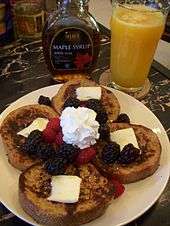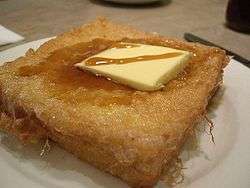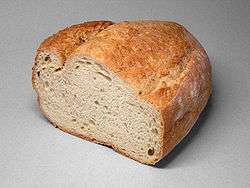French toast
French toast is a dish made of sliced bread soaked in eggs and typically milk, then pan fried. Alternative names and variants include "eggy bread",[1] "Bombay toast", "German toast",[2] "gypsy toast",[3] and "poor knights" (of Windsor).[4]
French toast served at a restaurant | |
| Place of origin | Roman Empire |
|---|---|
| Serving temperature | Hot, with toppings |
| Main ingredients | Bread, eggs |
| Ingredients generally used | Milk or cream, herbs, spices, sauces, syrups |
| Variations | Sweet |
When French toast is served as a sweet dish, milk, sugar, vanilla or cinnamon are also commonly added before pan-frying, and then it may be topped with sugar (often powdered sugar), butter, fruit, or syrup. When it is a savory dish, it is generally fried with a pinch of salt and/or pepper, and can then be served with a sauce such as ketchup or mayonnaise. [5] [6] [7] [8]
History
The earliest known reference to French toast is in the Apicius, a collection of Latin recipes dating to the 4th or 5th century, where it is described as simply aliter dulcia ("another sweet dish").[9] The recipe says to "Break [slice] fine white bread, crust removed, into rather large pieces which soak in milk [and beaten eggs] fry in oil, cover with honey and serve.""[10]
A fourteenth-century German recipe uses the name Arme Ritter ("poor knights"),[11][12] a name also used in English[4] and the Nordic languages. Also in the fourteenth century, Taillevent presented a recipe for "tostées dorées".[13] Italian 15th-century culinary expert Martino da Como offers a recipe.[14]
The usual French name is pain perdu (French: [pɛ̃ pɛʁdy] (![]()
An Austrian and Bavarian term is pafese or pofese, from zuppa pavese, referring to Pavia, Italy.[19] The word "soup" in the dish's name refers to bread soaked in a liquid, a sop. In Hungary, it is commonly called bundáskenyér (lit. "furry bread").[20]
Preparation

Slices of bread are soaked or dipped in a mixture of beaten eggs, often whisked with milk or cream. Sugar, cinnamon, nutmeg, and vanilla may be variously added to the mixture. The bread is then fried in butter or olive oil until browned and cooked through. Day-old bread is often used, both for its thrift and because it will soak up more egg mixture without falling apart.[21]
The cooked slices may be served with sugar or sweet toppings such as jam, honey, fruit,[22] or maple syrup.
International versions
Portugal and Brazil
In both Portugal and Brazil, rabanadas are a traditional Christmas dessert. [26]
Algeria
In Algeria, pin doray
Québec
In Québec, pain doré
India
In India, Bombay toast is a dish sold on the "streets of Mumbai" by hawkers and vendors,[28] Bombay toast is also called Sweet French Bread.[29]
Germany
In Germany, Arme Ritter (Poor Knights) or Pofesen are at least known since the 14th century (mentioned in Deutsches Wörterbuch (The German Dictionary) by the Brothers Grimm[30]).
Norway
In Norway, Arme Riddere (Poor Knights). Once only a dessert dish is now eaten for brunch or breakfast. The only additional ingredient is Cardamom.[31]
Denmark
In Denmark, Arme Riddere (Poor Knights) is a sweet breakfast dish, that can also be eaten as an afternoon treat or evening dessert. The Danish version of this dish uses sugar with cinnamon, instead of plain sugar.[32][33]
Spain
Torrija[11] is a similar recipe traditionally prepared in Spain for Lent and Holy Week. It is usually made by soaking stale bread in milk or wine with honey and spices. It is dipped in beaten egg and fried with olive oil. This cooking technique breaks down the fibres of the bread and results in a pastry with a crispy outside and smooth inside.[34] It is often sprinkled with cinnamon as a final touch.
Torrijas or torrejas were first mentioned by the Spanish composer, poet and playwright Juan del Encina (1468–1533) in his Cancionero, published in 1496. "Anda acá pastor" has the verse "En cantares nuevos/ gocen sus orejas,/ miel y muchos huevos/ para hacer torrejas,/ aunque sin dolor/ parió al Redentor".[35]
Hong Kong

Hong Kong-style French toast (Chinese: 西多士; Cantonese Yale: sāidōsí; lit.: 'western toast') is typically prepared by combining multiple slices of bread with peanut butter or fruit jam filling, then dipping in beaten egg and deep frying. It is served with butter, and topped with golden syrup or honey. It is a typical offering in Hong Kong teahouses (cha chaan teng).[36] Other types of filling that can be found are meat floss, kaya jam, ham, or beef satay.[36][37]
United States
French toast was popularly served in railroad dining cars of the early and mid-20th century. The Santa Fe was especially known for its French toast, and most of the railroads provided recipes of these and other dining car offerings to the public as a promotional feature.[38]
New Orleans
In New Orleans Louisiana Creole cuisine, French toast is known as pain perdu and is most commonly served as a breakfast dish.[39] The recipe calls for New Orleans-style French bread; the batter is an egg-based custard that may include spirits.[39][40][41] Common toppings include cane syrup, strongly flavored honey, or fruit syrups; a dusting of powdered sugar is also traditional.[40][41]
Romania
In Romania it is known as frigănele and, almost always, served as a savory dish, and, often enough, without milk.[42]
Poland
In Poland it is known as "chleb w jajku", which means egg-bread. It is a popular breakfast dish.
Greece
In Greece it is known as avgofétes which means egg-breads and is served as a breakfast dish with sugar and hazelnut spread, and if served with kasseri, is sometimes a savory dish.
United Kingdom
In the UK, it is commonly known as "eggy bread" or occasionally as "Gypsy toast"[43]and is served as both a sweet and as a savory dish.
See also
References
- Beckett, Fiona (18 September 2010). "Student cookbook: French toast (a.k.a. eggy bread)". The Guardian. Retrieved 13 December 2012.
- Farmer, Fannie Merritt (1918). The Boston Cooking-School Cook Book. Boston: Little, Brown; republished at Bartleby.com, 2000. Retrieved 6 April 2015.
- Mille (24 February 2002). "Gypsy Toast". food.com. Archived from the original on 29 November 2014. Retrieved 19 January 2015.
- Oxford English Dictionary, 3rd ed., 2006, s.v. 'poor' S3
- Rachel Phipps. "Eggy Bread". BBC Food. Retrieved 27 February 2020.
- Jamie Oliver. "How to make French toast". Retrieved 27 February 2020.
- "Eggy Bread". Australia's best recipes. Retrieved 27 February 2020.
- "How To Make Yumurtalı Ekmek (Eggy Bread)". Turkey's for life. Retrieved 27 February 2020.
- Joseph Dommers Vehling, trans., Apicius: Cookery and Dining in Imperial Rome, Book VII, chapter 13, recipe 296 full text at Gutenberg
- "Apicius, Book VII". LacusCurtius.
- Koerner, Brendan. "Is French Toast Really French?". Slate.com. Retrieved 6 April 2015.
- Grimm, Jacob and Wilhelm. Deutsches Wörterbuch, quoting from the Buch von guter Spyse.
- Pichon, Jérôme; Vicaire, Georges (1892). Le Viandier de Guillaume Tirel dit Taillevent. p. 262.
- Odile Redon, et al., The Medieval Kitchen: Recipes from France and Italy, 2000, p. 207f
- Gabriel Meurier, Christoffel Plantijn, Vocabulaire francois-flameng, 1562 p. 83
- Trésor de la Langue Française Informatisé s.v. pain
- Austin, T. Two 15th-century Cookery-books, 1888, quoting a 1450 recipe, quoted in the Oxford English Dictionary
- Davidson, Alan; Jaine, Tom (2006). The Oxford Companion to Food. Oxford University Press. p. 102. ISBN 0-19-280681-5.
- Ulrich Ammon, Variantenwörterbuch des Deutschen: die Standardsprache in Österreich, der Schweiz und Deutschland sowie in Liechtenstein, Luxemburg, Ostbelgien und Südtirol, 2004, ISBN 3110165759, p. 552
- "French toast, az @édes @bundás kenyér".
- Brown, Alton. "French Toast-Food Network".
- "French Toast Toppings – Unique French Toast Recipes". Good Housekeeping. Retrieved 19 January 2015.
- [Compleat Cook (1659) as quoted in the OED Citation incomplete, needs improvement]
- John Ayto, The Diner's Dictionary: Word Origins of Food and Drink, ISBN 0199640246, p. 142
- Adam Islip, A Dictionarie [sic] of the French and English Tongues, 1611, full text
- Rabanada, um antigo clássico natalino presente em todo o mundo (in Portuguese)
- "Le pain perdu: son histoire et ses origins" [Pain perdu: its history and origins]. lecercledesliberaux.com (in French). 25 May 2017. Retrieved 19 August 2019.
- Jayashri (23 April 2019). "Bombay Toast - Indian French Toast". Three Whistles Kitchen. Retrieved 15 October 2019.
- White, Bridget. "Sweet French Toast (Bombay Toast) - Anglo-Indian - Family friendly - Recipe". Retrieved 8 October 2016.
- Grimm, Jacob; Grimm, Wilhelm (eds.). "Armeritter". Deutsches Wörterbuch. I A–Biermolke.
- Strong, Daytona (22 August 2017). "Norway's answer to French toast". The Norwegian American. Retrieved 15 October 2019.
- Garde, Christian (1 April 2017). "Mærkelige madnavne: Hvorfor hedder det arme riddere?". Samvirke.dk (in Danish).
- Vollmer, Jesper. "Arme riddere". DR.dk (in Danish).
- Lepard, Dan (20 July 2012). "Dan Lepard's recipes for Basque butter buns, plus fried milk bread (a.k.a. torrija)". The Guardian. Retrieved 11 March 2015.
- Marta Haro Cortés. "La teatralidad en los villancicos pastoriles de Juan del Encina". Biblioteca Virtual Miguel de Cervantes. Retrieved 23 March 2016.
- CNN Go World's 50 most delicious foods Archived 2011-10-08 at the Wayback Machine 21 July 2011. Retrieved 2011-10-11
- "香港獨一無二的沙爹牛肉法式吐司" [Hong Kong's unique beef satay french toast] (in Chinese). Retrieved 7 August 2017.
- Kelly, John (21 February 2001). "Last call to dinner". Classic Trains Magazine. Retrieved 8 September 2018.
- Tabacca, Laura. "New Orleans Style Pain Perdu (French Toast)". The Spiced Life. Retrieved 25 November 2017.
- "Pain Perdu". The Gumbo Pages. Retrieved 25 November 2017.
- Mitzewich, John. "New Orleans-style French Toast "Pain Perdu"". The Spruce. Retrieved 25 November 2017.
- "Friganele reteta copilariei – paine cu ou sau bundás kenyér". SavoriUrbane.com (in Romanian). 5 April 2018.
- Mille (24 February 2002). "Gypsy Toast". food.com. Archived from the original on 29 November 2014. Retrieved 19 January 2015.
Further reading
- Claiborne, Craig (1985). Craig Claiborne's The New York Times Food Encyclopedia. New York: Times Books. ISBN 0-8129-1271-3.
- Farmer, Fannie (1918). The Boston Cooking-School Cook Book. Boston: Little, Brown and Co.
- Mariani, John F. (1999). The Encyclopedia of American Food and Drink. New York: Lebhar-Friedman. ISBN 0-86730-784-6.
- Redon, Odilie (1998). The Medieval Kitchen: Recipes from France and Italy. Chicago: Univ. Chicago Press. ISBN 0-226-70684-2.
External links
| Wikimedia Commons has media related to French toast. |
| Wikibooks Cookbook has a recipe/module on |
| Wikiquote has quotations related to: French toast |
